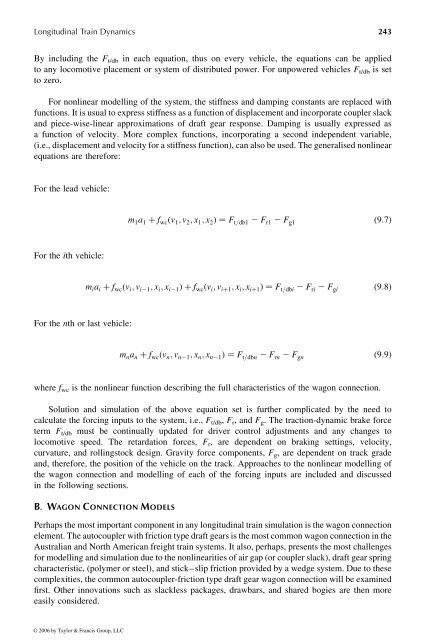Hi-Res PDF - CRCnetBASE
Hi-Res PDF - CRCnetBASE
Hi-Res PDF - CRCnetBASE
You also want an ePaper? Increase the reach of your titles
YUMPU automatically turns print PDFs into web optimized ePapers that Google loves.
Longitudinal Train Dynamics 243<br />
By including the F t/db in each equation, thus on every vehicle, the equations can be applied<br />
to any locomotive placement or system of distributed power. For unpowered vehicles F t/db is set<br />
to zero.<br />
For nonlinear modelling of the system, the stiffness and damping constants are replaced with<br />
functions. It is usual to express stiffnessasafunction of displacement and incorporate coupler slack<br />
and piece-wise-linear approximations ofdraft gear response. Damping is usually expressed as<br />
afunction of velocity. More complex functions, incorporating asecond independent variable,<br />
(i.e., displacement and velocity for astiffness function), can also be used. Thegeneralised nonlinear<br />
equations are therefore:<br />
For the lead vehicle:<br />
For the i th vehicle:<br />
For the n th or last vehicle:<br />
m 1 a 1 þ f wcð v 1 ; v 2 ; x 1 ; x 2 Þ¼F t = db1 2 F r1 2 F g1<br />
m i a i þ f wcð v i ; v i 2 1 ; x i ; x i 2 1 Þþf wcð v i ; v i þ 1 ; x i ; x i þ 1 Þ¼F t = dbi 2 F r i 2 F g i<br />
m n a n þ f wcð v n ; v n 2 1 ; x n ; x n 2 1 Þ¼F t = dbn 2 F r n 2 F g n<br />
where f wc is the nonlinear function describing the full characteristics of the wagon connection.<br />
Solution and simulation of the above equation set is further complicated by the need to<br />
calculate the forcing inputs to the system, i.e., F t/db, F r ,and F g .The traction-dynamic brake force<br />
term F t/db must be continually updated for driver control adjustments and any changes to<br />
locomotive speed. The retardation forces, F r , are dependent on braking settings, velocity,<br />
curvature, and rollingstock design. Gravity force components, F g ,are dependent on track grade<br />
and, therefore, the position of the vehicle on the track. Approaches to the nonlinear modelling of<br />
the wagon connection and modelling ofeach of the forcing inputs are included and discussed<br />
in the following sections.<br />
B . W AGON C ONNECTION M ODELS<br />
Perhaps the most important component in any longitudinal train simulation is the wagon connection<br />
element. The autocoupler with friction type draft gearsisthe mostcommon wagon connection in the<br />
Australian and North American freight train systems. It also, perhaps, presents the mostchallenges<br />
for modellingand simulation due to the nonlinearities of air gap (or coupler slack), draft gear spring<br />
characteristic, (polymer or steel),and stick–slip friction provided by awedge system. Due to these<br />
complexities, the common autocoupler-frictiontype draft gear wagon connection will be examined<br />
first. Other innovations such as slackless packages, drawbars, and shared bogies are then more<br />
easily considered.<br />
© 2006 by Taylor & Francis Group, LLC<br />
ð 9 : 7 Þ<br />
ð 9 : 8 Þ<br />
ð 9 : 9 Þ









